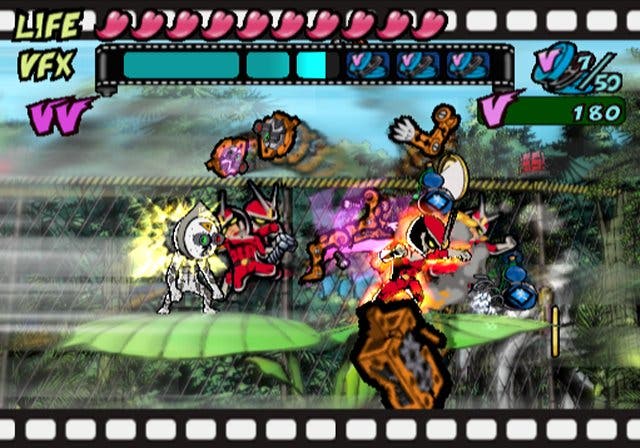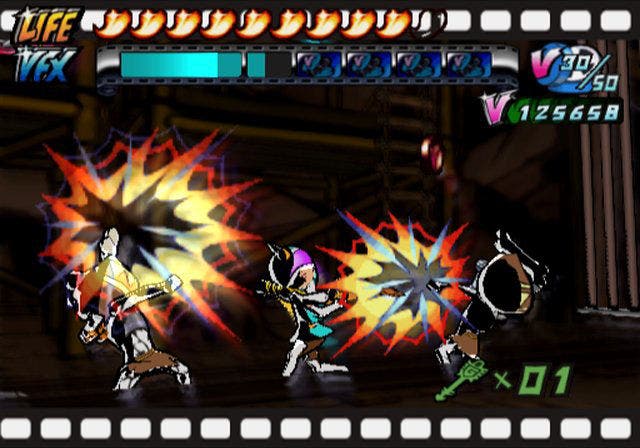Viewtiful Joe for the Average Joe
Our worryingly skilled pal Saurian demonstrates how to be brilliant at Viewtiful Joe. Watch him kick backsides to the tune of 9999 Viewtifuls, and then read how he did it.

These days, not everyone has time to figure things out for themselves. That's why we have little shortcuts that we all take for granted. When you want to know the time, you look at a watch; when you want to eat a pizza, you call Domino's; when you realise you want to visit Plymouth, you go and see a psychiatrist. Etcetera. So why shouldn't the same be true of games? Everyone loves the thrill of making something really hard look really easy, but not everybody has time enough to get truly stuck in and uncover the hidden depths.
Fortunately, like everything games can be unravelled and taught. Even the higher end stuff. And one game that could certainly do with a bit of demystifying in the eyes of the average gamer is Viewtiful Joe, a game whose combo system is so advanced that we've reviewed three versions of it and still haven't found everything. So, to mark the recent release of Viewtiful Joe on PS2 and Viewtiful Joe 2 on PS2 and GameCube, we've managed to convince hardcore VJ fan Saur "Saurian" Dash to school the likes of us in being awesome at this awesome game. What follows is a no-nonsense guide to getting the most out of the combo system.
But don't worry if you haven't even bought Viewtiful Joe yet. We're not out to exclude, which is why Saurian's guide is accompanied by this frankly extraordinary video (37MB, and you'll need the XVID codec) showcasing his talents. As you'll note, throughout the text below there are references to key elements of the video, too, with a little note in brackets telling you where and when to pay attention. So whether you love Viewtiful Joe already, only half-liked it, or haven't even given it a proper look, you should at least download the video - and for those of you wondering how to get the most out of it, look no further. Over to you, Saurian.

Er, thanks! Right then. Let's not dilly-dally.
A combo will start when you dodge and stun an opponent. Enemies such as the bog-standard Biankies will be stunned after just one dodge, but there are some with different properties - like the black-clothed Cromarties, which need four dodges in a row (video demo: 01:48). So it's important to learn how to dodge and stun each enemy type. Boss encounters also follow this formula.
Once the combo initiates, an unseen countdown begins. Basically, when you see a V sign below your VFX bar, a combo has started. You reset the timer and keep the combo going by hitting a stunned enemy or dodging again, and this is where you build up points and set up your and their positions for the VFX finish (01:21). What's important here is to learn how many hits each enemy type can take before they die. Ideally, you want to stun all enemies on screen and inflict maximum hits on all of them. So work out a set-up sequence where you stun an enemy, inflict maximum damage without killing; move to the next one, stun; and so on until all have taken the maximum sits possible. Only then do you start using Slow VFX.
When the set-up is complete, hit Slow and hold it. Now each enemy you hit while in Slow will increment a multiplier which will be applied to the combo points you scored during the set-up by one (01:33). You must start the multiply combo within Slow by hitting a stunned enemy first. This will apply a target crosshair to all enemies onscreen signifying that they will be included in the current multiply combo if hit before you stop using Slow. The combo will end if you release Slow or lose your VFX power through overuse.
With a good set-up coupled with a big finish in Slow, striking many enemies, you can actually max out the combo points at 9999 Viewtifuls. There's only one word for that, and I just said it.

You can use Mach Speed freely during your set-ups. It acts exactly like a normal attack and wont reset or reduce your combo score. But be careful, as it's easy to kill enemies accidentally while using it. During some sections, extra enemies jump in after existing ones are finished, so a good tactic here is to kill the extra ones during the set0up sequence so that once you finish in Slow no more can join in. It's worth learning the numbers, as the kills will add more points to your total, and you won't have to mop up extras after the main event. (00:29)
Sylvia's Replay acts exactly as Mach Speed does with regard to use within combos. It wont reset your combo in real time or within Slow, so feel free to add it wherever you can to score extra hits! Replay reduces the VFX bar by blocks of two each time you connect it. The key is not to go mad with it. In real time you can use it quite freely, but within Slow it eats away at valuable VFX power so use it carefully! (00:44)
Movement during Slow is an art! Animation cancels are vital if you want to have total control over directional changes and attack delays, making it possible to completely override them saving valuable seconds. Joe, for example, won't change direction instantly within Slow if you use standard directional control, but you can cancel the animations of any move, even in opposing directions, for instant turns. The rule is that kick cancels punch and vice versa. So, suppose you've thrown a punch which has connected to an enemy on the left. Cancel the end of the punch into a kick while holding right and Joe will instantly kick to the right. The better you get at it the more you can play about with the animation, for example cancelling that opposing kick a couple of frames in and going into an uppercut (perhaps hitting Zoom for dramatic effect).
In Slow, Joe wont start walking until he's finished whatever move you've just thrown, so, after hitting an enemy, walking to the next enemy to score the hit will waste time as Joe must finish the move, turn around, start walking then start the new move. This is not fast enough for good combos. However, with animation-cancels you can get Joe to track sideways quickly with the ability to switch direction instantly in 2 ways.

Firstly, rapid kick/punch cancels so that he keeps stepping (tracking forwards) while just about ready to attack. (02:29)
Secondly, sliding to uppercut cancel. Once you've purchased the sliding move, it's down plus kick, while uppercut is down and punch. Cancel the end of Sliding into just a couple frames of the uppercut then back to Sliding and so on (01:32 - this section of the video shows this trick used as an attack so the uppercut is allowed to connect rather than cancelled immediately).
Another feature is that you can hold Mach Speed within Slow for extra speed while running. This is good for moving greater distances, but within combos kick/punch cancelling is so much faster and more versatile.
Attack type is vital in Slow. Kicks will knock enemies away diagonally while punches send them vertically or horizontally depending on whether it's an uppercut or straight attack. So make sure you don't smash enemies into each other, as this will damage enemies that you've positioned for the multiplier. Make sure they are rounded up in your initial set-up, then smash them upwards or away from each other so you don't have to move about to reach all of them, wasting valuable VFX time. Red Hot Kick will always send enemies diagonally up, standing kicks or sweeps both launch them at 45 degrees, while punch is simply straight forward and uppercut straight up. Once you learn how to aim enemies and position them during the set-ups you can smash them up into unreachable areas to get more V cans to fill the VFX bar.
So there you are. That should give you plenty to go on, and hopefully this guide will attract new players to Viewtiful Joe as well as helping existing players get more out of the game. Viewtiful Joe is a work of genius - what you put in, you get back out twofold, and it deserves any gamer's undivided attention!
Indeed it does. Thanks to Saurian for this walkthrough. The copyright is his own. And be sure to let us know whether you enjoyed it and would like to see more, similar guides in future.

